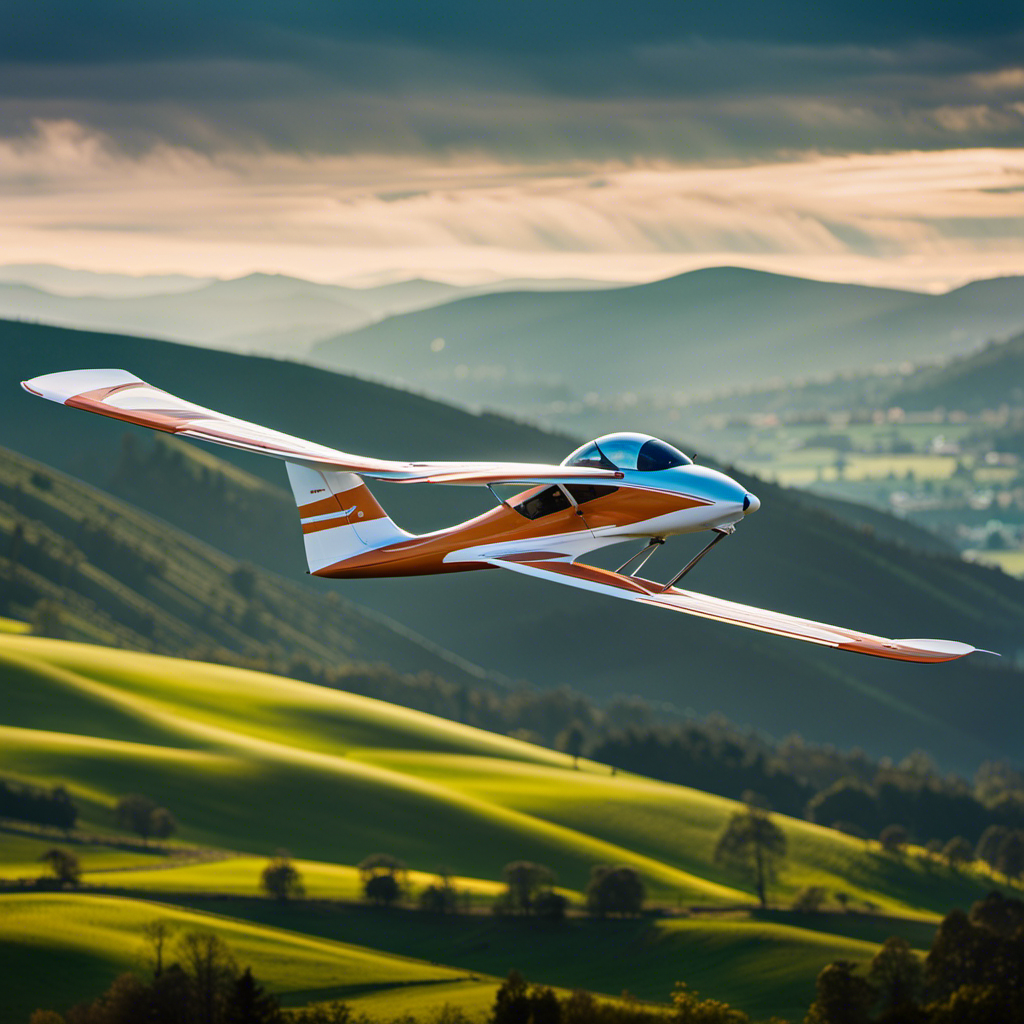While soaring through the sky and feeling the wind against my face, I discovered that gliding was my ultimate passion.
Joining a glider club has been an incredible journey, filled with thrilling experiences and a sense of camaraderie like no other.
In this article, I’ll share everything you need to know about joining a glider club. From the basics of gliding to finding the perfect club for you, we’ll explore the benefits, activities, and safety measures that come with this exhilarating hobby.
So buckle up and get ready to take flight!
Key Takeaways
- Joining a glider club provides access to experienced pilots for learning and training programs.
- Glider clubs offer networking opportunities with other pilots and discounts on aircraft rental and club events.
- Getting started with gliding involves finding a reputable flight school or club, completing ground school classes, and earning a glider pilot certificate.
- Glider club activities and events include participating in competitions, engaging in social activities, attending guest speaker presentations, and joining fly-ins and airshows.
The Basics of Gliding
Gliding is a thrilling and adrenaline-pumping sport that involves flying a motorless aircraft. As a glider pilot, understanding the basics of gliding and mastering the proper techniques is essential for a safe and enjoyable experience in the air.
To begin, gliding starts with a launch, typically using a winch or a tow plane. Once airborne, the pilot relies on the natural elements to stay aloft. By finding rising air currents, such as thermals or ridge lift, gliders can maintain altitude and even climb to higher altitudes. Understanding how to locate and utilize these lift sources is crucial for extending flight time and covering greater distances.
In terms of techniques, glider pilots must become adept at reading the sky and understanding weather patterns. This involves studying cloud formations, wind direction, and other atmospheric indicators. Additionally, pilots need to learn proper maneuvering techniques, including turns, stalls, and landings. These skills are honed through practice and instruction from experienced glider pilots.
Benefits of Joining a Glider Club
One of the advantages of becoming a member is the opportunity to meet experienced pilots and learn from them. Joining a glider club provides numerous benefits of networking and learning opportunities. When you become a member of a glider club, you gain access to a community of experienced pilots who are always willing to share their knowledge and experiences. These pilots have a wealth of information about gliding techniques, weather patterns, and navigation strategies that they can pass on to you. By networking with these individuals, you can expand your knowledge and skills in the field of gliding.
In addition to learning from experienced pilots, joining a glider club also gives you the chance to participate in various training programs and workshops. These programs are designed to enhance your skills and provide you with the necessary knowledge to become a proficient glider pilot. Whether it’s learning advanced maneuvers or understanding meteorology, these learning opportunities can greatly benefit your gliding journey.
Transitioning into the next section about finding a glider club, it’s important to note that once you realize the benefits of joining a glider club, the next step is to find a club that suits your needs and preferences.
Finding a Glider Club
When searching for a glider club, it’s important to consider your preferences and needs. Here are some key points to consider:
-
Location: Look for a club that is conveniently located for you, taking into account the distance you are willing to travel.
-
Facilities: Check if the club has well-maintained facilities, including hangars, runways, and briefing areas.
-
Glider Instructors: Ensure that the club has experienced and certified glider instructors who can provide quality training and guidance.
-
Membership Benefits: Consider the benefits offered by the club, such as discounted rates for aircraft rental, access to club events and social activities, and the opportunity to connect with other gliding enthusiasts.
Finding a glider club that meets your needs and offers a range of benefits is crucial for a fulfilling gliding experience.
Once you have found the right club, you can move on to the next step of getting started with gliding, learning the basics of flying a glider, and experiencing the thrill of soaring through the skies.
Getting Started with Gliding
It’s important to start by familiarizing yourself with the basics of flying a glider. Learning to fly a glider is an exciting and rewarding journey that requires dedication and commitment.
The first step in getting started with gliding is to find a reputable flight school or glider club that offers training programs. Look for clubs that have experienced instructors and a good safety record.
Once you have found a suitable club, you can begin the process of getting certified to fly a glider. This involves completing a series of ground school classes, where you will learn about aerodynamics, meteorology, and other essential topics. You will also need to pass a written exam to demonstrate your knowledge.
After completing the ground school, you will start your flight training. This will involve hands-on practice with an instructor, who will teach you how to control the glider and perform various maneuvers. As you gain experience and confidence, you will progress to more advanced flight exercises.
By the time you complete your training and meet all the requirements, you will be ready to take the final flight test to earn your glider pilot certificate. This certificate will allow you to fly a glider solo and participate in glider club activities and events.
Transitioning into the subsequent section about ‘glider club activities and events’, it’s important to note that joining a glider club opens up a world of opportunities for gliding enthusiasts.
Glider Club Activities and Events
Attending glider club activities and events provides an excellent opportunity to connect with fellow gliding enthusiasts and learn from experienced pilots. It’s not just about flying; it’s about being part of a community that shares your passion for gliding.
Here are five exciting aspects of glider club activities and events:
-
Glider Club Competitions: Participating in glider club competitions allows you to put your skills to the test and challenge yourself. It’s a chance to showcase your abilities and compete against other skilled pilots. These competitions range from local club-level events to national and international championships, providing a thrilling experience for all participants.
-
Glider Club Social Activities: Glider clubs organize various social activities to foster camaraderie among members. From barbecues and picnics to social evenings and parties, these events offer a chance to relax, unwind, and connect with like-minded individuals. It’s a great way to build lasting friendships and expand your gliding network.
-
Guest Speaker Presentations: Glider clubs often invite guest speakers who are experts in the field of gliding. These presentations cover a wide range of topics, including advanced flying techniques, safety procedures, and the latest advancements in glider technology. Listening to these experienced pilots share their knowledge can be incredibly informative and inspiring.
-
Fly-ins and Airshows: Glider clubs frequently organize fly-ins and airshows, where pilots from different clubs come together to showcase their skills and aircraft. These events offer a fantastic opportunity to witness breathtaking aerial displays, interact with pilots from other clubs, and experience the excitement of being part of a larger gliding community.
-
Training Workshops: Glider clubs often conduct training workshops to help members enhance their skills and knowledge. These workshops cover various subjects, including cross-country flying, meteorology, navigation techniques, and emergency procedures. Attending these workshops can greatly contribute to your growth as a glider pilot.
By participating in glider club activities and events, you not only enhance your gliding skills but also form valuable connections within the gliding community.
Now, let’s move on to explore the exceptional facilities and resources offered by glider clubs.
Glider Club Facilities and Resources
Glider clubs provide a wide range of facilities and resources to support pilots in their pursuit of gliding excellence. These clubs understand the importance of creating an environment that fosters learning and growth for glider pilots.
One of the key amenities offered by glider clubs is access to well-maintained gliders. These high-performance aircraft are equipped with state-of-the-art instruments and are regularly inspected to ensure safety and reliability.
In addition to gliders, glider clubs also provide access to a variety of other amenities. Many clubs have spacious hangars where pilots can store their gliders and equipment. These hangars also serve as a social hub, allowing pilots to connect with fellow enthusiasts and share their experiences. Furthermore, glider clubs often have workshops where pilots can perform minor repairs and maintenance on their gliders.
To support pilots in their pursuit of gliding excellence, glider clubs offer comprehensive training programs. These programs are designed to cater to pilots of all skill levels, from beginners to advanced. They typically include theoretical lessons on topics such as aerodynamics, meteorology, and navigation, as well as practical flight training with experienced instructors. Glider clubs also organize regular training camps and competitions, providing pilots with opportunities to enhance their skills and compete with others.
As pilots take to the skies, safety becomes a paramount concern. Glider clubs prioritize safety by implementing strict protocols and procedures. From pre-flight checks to emergency procedures, glider clubs ensure that pilots are well-prepared for any situation that may arise. By placing safety at the forefront, glider clubs create an environment that allows pilots to pursue their passion for gliding with confidence and peace of mind.
Safety in Gliding
When you take to the skies in a glider, ensuring safety is of utmost importance. Gliding may seem like a serene and graceful activity, but it is essential to follow proper safety precautions and be prepared for any emergencies that may arise. Here are some key safety measures to keep in mind when gliding:
-
Pre-flight Safety Checks:
-
Inspect the glider thoroughly, checking for any signs of damage or malfunctions.
-
Verify that all safety equipment, such as parachutes and emergency radios, are in good working condition.
-
In-Flight Safety Procedures:
-
Maintain constant awareness of weather conditions, including wind speed and direction.
-
Adhere to altitude limits and airspace restrictions to avoid collisions with other aircraft.
In addition to these precautions, it is crucial to be familiar with emergency procedures:
-
Emergency Landing:
-
Identify suitable landing spots in case of an engine failure or other emergencies.
-
Practice emergency landing techniques, including proper approach and touchdown procedures.
-
Mid-air Collision Avoidance:
-
Stay vigilant and communicate with other gliders using hand signals or radio communication.
-
Follow traffic patterns and maintain a safe distance from other gliders to prevent accidents.
By following these safety precautions and being prepared for emergencies, you can enjoy the thrill of gliding while minimizing risks.
Transitioning into the next section, it is important to consider the differences between gliding as a hobby and gliding as a career.
Gliding as a Hobby vs. a Career
When it comes to gliding, there are a few key points to consider.
Firstly, exploring gliding as a recreational activity can be a thrilling and rewarding experience.
Secondly, for those who aspire to pursue a career in aviation, gliding can be a stepping stone towards professional pilot opportunities.
Lastly, it’s important to find a balance between gliding and other commitments, as the sport requires time and dedication.
Exploring Recreational Gliding
If you’re looking for an exhilarating way to spend your weekends, exploring recreational gliding might be just what you need. Recreational gliding offers a unique opportunity to experience the freedom of flight without the need for an engine.
One of the best ways to get started is by joining a glider club. Glider clubs provide access to training, equipment, and a supportive community of fellow enthusiasts. Membership in a glider club typically involves an annual fee, which covers the cost of maintenance, insurance, and access to the club’s facilities and gliders.
Pursuing Professional Pilot Opportunities
After delving into the world of recreational gliding, it is important to acknowledge that gliding can also lead to exciting professional pilot opportunities. Many glider clubs offer professional pilot training programs, where aspiring pilots can gain the necessary skills and knowledge to pursue a career in aviation.
These programs typically include theoretical and practical training, covering topics such as aerodynamics, navigation, meteorology, and flight planning. By completing such training, individuals can open doors to various career opportunities, including becoming a commercial airline pilot, a flight instructor, or even a test pilot. The demand for pilots is expected to grow in the coming years, creating ample job prospects for those who have undergone professional pilot training.
So, if you have dreams of soaring through the skies as a professional pilot, joining a glider club and participating in their training programs can be a stepping stone into the aviation industry.
Now, let’s explore how to balance the exhilaration of gliding with our other commitments.
Balancing Gliding with other Commitments
Finding a balance between gliding and our other commitments can be challenging, but it is possible with proper time management and prioritization. Here are three key strategies to help manage your time effectively while balancing gliding with work and other responsibilities:
-
Prioritize and schedule: Determine which commitments are the most important and allocate specific time slots for each activity. This will help you stay organized and ensure that you have enough time for gliding without neglecting other responsibilities.
-
Set realistic goals: Be realistic about the time you can dedicate to gliding each week. Set achievable goals that align with your schedule and workload, allowing you to enjoy gliding without feeling overwhelmed.
-
Communicate and negotiate: Openly communicate with your employer, colleagues, and family about your gliding commitments. Negotiate flexible working hours or discuss ways to delegate tasks to create more time for gliding.
By implementing these strategies, you can successfully balance gliding with your other commitments, ensuring a fulfilling and enjoyable gliding experience.
Now, let’s explore some tips for a successful gliding experience.
Tips for a Successful Gliding Experience
To have a successful gliding experience, you’ll want to familiarize yourself with the equipment and safety protocols. When it comes to glider safety, there are a few key tips to keep in mind.
First and foremost, always conduct a thorough pre-flight inspection of your glider before each flight. This includes checking the control surfaces, cables, and connections for any signs of wear or damage. Additionally, it’s important to ensure that you are properly equipped with a parachute and know how to use it in case of an emergency.
Improving your gliding skills is another crucial aspect of a successful gliding experience. One tip is to practice your landings regularly, as they can be one of the more challenging aspects of gliding. It’s also helpful to seek guidance from experienced gliders or instructors who can provide valuable tips and techniques. Additionally, take advantage of any opportunities for cross-country flights, as they can help you develop better navigation skills and increase your understanding of different weather conditions.
Now, let’s move on to some frequently asked questions about glider clubs and the process of joining them.
Frequently Asked Questions about Glider Clubs
Joining a glider club is a great way to indulge in the thrilling experience of gliding. However, it’s important to understand the costs involved. The membership fees for glider clubs can vary depending on the location and the services offered. While anyone can join a glider club, it’s essential to consider factors such as age requirements and any prerequisites that may be in place.
How Much Does it Cost to Join a Glider Club?
You’ll want to know how much it costs to become a member of a glider club. Here’s a cost comparison of different glider clubs I researched:
-
Membership fees: The cost of joining a glider club can vary depending on the club. Some clubs have an annual membership fee ranging from $500 to $1,000, while others may charge a one-time initiation fee of $2,000 or more.
-
Flying fees: In addition to the membership fee, most glider clubs charge flying fees. These fees cover the cost of renting a glider and can range from $50 to $200 per hour of flight time.
-
Additional benefits: Along with the cost, it’s important to consider the membership benefits. Some clubs offer discounted rates for lessons, access to advanced glider models, and social events. These perks can add value to your membership experience.
Transition: Now that we have an idea of the costs and benefits, let’s explore who can join a glider club.
Can Anyone Join a Glider Club?
Anyone who meets the eligibility requirements can become a member of a glider club. Joining a glider club requires meeting certain criteria, such as having a valid pilot’s license, completing a medical examination, and attending a training program. These joining requirements ensure that members have the necessary skills and qualifications to safely participate in gliding activities.
Additionally, some glider clubs may have specific age restrictions or experience requirements for joining. It is important to carefully review the eligibility criteria set by each glider club before applying for membership.
Now, let’s delve into the minimum age requirement for gliding and explore how young enthusiasts can get involved in this thrilling sport.
What is the Minimum Age Requirement for Gliding?
When it comes to joining a glider club, there are certain requirements that need to be met. In my previous subtopic, I discussed the general eligibility criteria for joining a glider club.
Now, let’s delve into the specific minimum age requirement for gliding. The minimum age requirement varies depending on the country and the gliding organization. In most countries, the minimum age to start gliding is 14 years old. However, some organizations may have a higher minimum age requirement, such as 16 or even 18 years old.
This requirement is in place to ensure that individuals have the necessary maturity and physical capabilities to handle gliding activities safely. It is important to check with your local glider club or the national gliding association to determine the minimum age requirement for gliding in your region.
Frequently Asked Questions
How much does it cost to join a glider club?
Glider club membership fees vary depending on the club and location. The benefits of joining a glider club include access to gliders and equipment, training opportunities, camaraderie with fellow pilots, and the chance to participate in competitions and events.
Can I bring my own glider to a glider club?
Yes, you can bring your own glider to a glider club. However, if you don’t own one, most glider clubs offer rental options for gliders and other equipment.
Are there age restrictions for joining a glider club?
There are age restrictions for joining a glider club, but they vary depending on the club. The benefits of joining include learning to fly gliders, meeting fellow aviation enthusiasts, and participating in club events and competitions.
Do glider clubs offer training for beginners?
Yes, glider clubs offer training for beginners. They provide beginner glider lessons to teach the fundamentals of flying a glider. Training typically includes ground instruction, flight simulations, and hands-on experience in the glider.
Can I participate in glider club activities without owning a glider?
Yes, I can participate in glider club activities without owning a glider. Equipment rental is available, allowing me to enjoy the experience and learn without the need for personal ownership.
Conclusion
In conclusion, joining a glider club can be an exhilarating and fulfilling experience. From the thrill of soaring through the sky to the camaraderie of fellow gliding enthusiasts, there are countless benefits to becoming a member.
Just like a glider gracefully glides through the air, being part of a club can provide the support and guidance needed to navigate this exciting hobby.
So, spread your wings and take flight with a glider club – you’ll be amazed at the heights you can reach!









